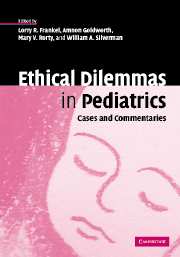Book contents
- Frontmatter
- Contents
- List of contributors
- Preface
- Introduction
- Part I Therapeutic misalliances
- 1.1 Unconventional medicine in the pediatric intensive care unit
- 1.2 Role responsibility in pediatrics: appeasing or transforming parental demands?
- 1.3 Topical discussion
- 2.1 The extremely premature infant at the crossroads
- 2.2 The extremely premature infant at the crossroads: ethical and legal considerations
- 2.3 Topical discussion
- 3.1 Munchausen syndrome by proxy
- 3.2 Some conceptual and ethical issues in Munchausen syndrome by proxy
- 3.3 Topical discussion
- Part II Medical futility
- Part III Life by any means
- Part IV Institutional impediments to ethical action
- References
- Index
2.2 - The extremely premature infant at the crossroads: ethical and legal considerations
Published online by Cambridge University Press: 18 August 2009
- Frontmatter
- Contents
- List of contributors
- Preface
- Introduction
- Part I Therapeutic misalliances
- 1.1 Unconventional medicine in the pediatric intensive care unit
- 1.2 Role responsibility in pediatrics: appeasing or transforming parental demands?
- 1.3 Topical discussion
- 2.1 The extremely premature infant at the crossroads
- 2.2 The extremely premature infant at the crossroads: ethical and legal considerations
- 2.3 Topical discussion
- 3.1 Munchausen syndrome by proxy
- 3.2 Some conceptual and ethical issues in Munchausen syndrome by proxy
- 3.3 Topical discussion
- Part II Medical futility
- Part III Life by any means
- Part IV Institutional impediments to ethical action
- References
- Index
Summary
Introduction
The retrospectoscope is usually a pleasure to use. After someone else's case turns out badly, simply direct the retrospectoscope at the original clinical events and explain calmly how you would have made better decisions, resulting in a better outcome. In the case of Baby Girl M, it is plain that aggressive management from the moment of birth would have avoided the awkward six hours in which she received comfort care only, but that is not the whole story. In fact, it is my thankless duty to assert that aggressive care was inappropriate at any time, and that optimal management would have resulted, not in survival, but in her prompt and intended death. That did not happen, and I am pleased for Baby Girl M herself, who is doing well, but her good outcome does not vindicate her initial management. To understand how she should have been managed, we must begin with the issues raised by infants who are born at the margin of viability.
This essay reviews the determination of viability, moves on to the legal doctrines that influence care decisions, discusses the way these issues illuminate the case of Baby Girl M, and concludes with recommendations for a process designed to lead to better decisions.
Shades of viability
An infant's chance of survival gradually increases with gestational age, so the limit of viability is blurred rather than distinct.
- Type
- Chapter
- Information
- Ethical Dilemmas in PediatricsCases and Commentaries, pp. 37 - 51Publisher: Cambridge University PressPrint publication year: 2005
- 1
- Cited by



